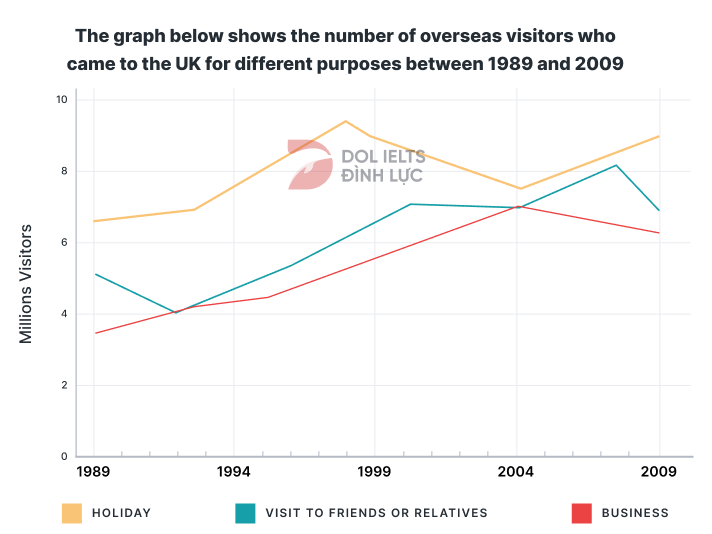Đề thi IELTS Writing Task 1 ngày 06/05/2023 kèm bài mẫu band 8
Bài mẫu sample band 8 IELTS Writing Task 1 ngày 06/05/2023: The graph below shows the number of overseas visitors who came to the UK for different purposes between 1989 and 2009.
🚀 Đề bài

😵 Dàn ý
DOL sẽ miêu tả biểu đồ với 1 câu mở bài (Intro), 1 đoạn miêu tả tổng quát (Overview), và 2 đoạn thân bài miêu tả chi tiết (Detailed Description).
Instruction: DOL sẽ paraphrase đề bài để giới thiệu lại đề cho giám khảo.
Overview:
- Xu hướng chung: số khách tham quan có xu hướng tăng ở cả 3 purposes.
- Đặc điểm nổi bật: đi nghỉ là lý do phổ biến nhất.
Body 1: DOL mô tả số liệu số lượng khách du lịch cho 3 mục đích năm 1989.
Body 2: DOL mô tả số liệu và xu hướng khách du lịch giai đoạn 1989 - 2009.
- Holiday: nearly 7 millions people --> most common.
- Seeing friends or relatives: over 5 million visitors --> the second most popular.
- Work reasons: only under 4 million.
- Holidaymakers: a peak of nearly 10 million (1999) >>> dropped below 8 million (2004) >>> rising back to 9 million (2009)
- Social purposes: a record low of 4 million (1993) >>> grew consistently afterwards, 7 million (2009)
- Business trips: peaking at 7 million (2004) >>> dropping slightly, over 6 million at the end of the period.
📝 Bài mẫu
The line chart illustrates how many foreign visitors traveled to the UK for different reasons over the course of 20 years, from 1989 to 2009.
Overall, visitor numbers
In 1989, nearly 7 million people traveled to the UK on vacation, making holiday trips the most common type of trip for those visiting the country. Seeing friends or relatives represented the second most popular reason for coming to the UK, with over 5 million visitors going here for this purpose. Not as many people made the trip to Britain for work reasons, as
In the period following 1989, the number of people who visited the UK as holidaymakers
(260 words)
📚 Vocabulary
✨ Bài tập Exercise
Mình cùng làm 2 bài tập sau đây để ôn lại các từ vựng và cấu trúc đã được dùng trong bài mẫu IELTS Writing nhé!
Exercise 1:
1 Giá cổ phiếu đã theo xu hướng tăng trong vài tháng qua, cho thấy triển vọng thị trường tích cực.
--> The stock prices have been
2 Cô ấy theo đuổi ước mơ của mình bất kể những trở ngại cản đường cô ấy.
--> She pursued her dreams
3 Giá cả các mặt hàng thường xuyên biến động do điều kiện thị trường.
--> The prices of commodities often experience
4 Trong suốt giai đoạn nghiên cứu, những người tham gia được theo dõi chặt chẽ về bất kỳ thay đổi nào trong hành vi của họ.
-->
5 Số liệu trên báo cáo bán hàng cho thấy doanh thu tăng đáng kể cho công ty.
-->
Exercise 2:
Điền từ thích hợp vào chỗ trống
tăng vọt
đỉnh
giảm
đạt mức thấp kỷ lục
tăng trưởng khá ổn định
giai đoạn được theo dõi
Học từ vựng và cấu trúc mới qua bài mẫu Writing task 2 IELTS ngày 06/05/2023 ngay nhé!
Đề thi Writing task 1 HOT trong tháng 05/2023.
💡 Lời kết
Sau sample The graph below shows the number of overseas visitors who came to the UK for different purposes between 1989 and 2009, DOL sẽ giúp bạn hệ thống lại những cấu trúc nổi bật và những điểm từ vựng, ngữ pháp band 8 nhé!
1. Sử dụng mệnh đề danh ngữ (nominal clause)
Ví dụ: The line chart illustrates how many foreign visitors traveled to the UK.
2. Mệnh đề quan hệ rút gọn (chủ động): SV1, which V2 --> SV1, V(2)_ing
Ví dụ: Nearly 7 million people traveled to the UK on vacation, making holiday trips the most common type of trip for those visiting the country.
3. Cấu trúc cause-effect: SV, as SV (as = because: bởi vì)
Ví dụ: Not as many people made the trip to Britain for work reasons, as the figure for this was only under 4 million.
4. Cấu trúc before + Ving: diễn tả một hành động diễn ra trước một hành động khác.
Ví dụ: This number dropped below 8 million in 2004 before rising back to 9 million in 2009. (drop diễn ra trước rising).
DOL hy vọng bạn sẽ có thể áp dụng được những cấu trúc, từ vựng và cách tiếp cận với line graph vào những đề tương tự nhé! 



